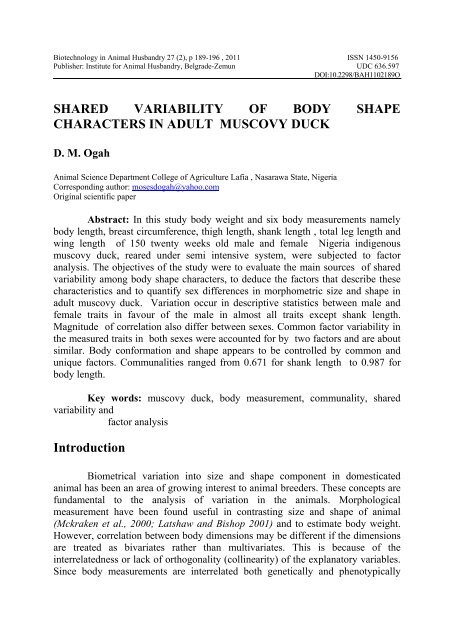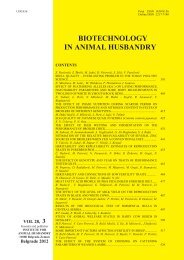Biotechnology in Animal Husbandry - Institut za Stočarstvo
Biotechnology in Animal Husbandry - Institut za Stočarstvo
Biotechnology in Animal Husbandry - Institut za Stočarstvo
You also want an ePaper? Increase the reach of your titles
YUMPU automatically turns print PDFs into web optimized ePapers that Google loves.
<strong>Biotechnology</strong> <strong>in</strong> <strong>Animal</strong> <strong>Husbandry</strong> 27 (2), p 189-196 , 2011 ISSN 1450-9156<br />
Publisher: <strong>Institut</strong>e for <strong>Animal</strong> <strong>Husbandry</strong>, Belgrade-Zemun UDC 636.597<br />
DOI:10.2298/BAH1102189O<br />
SHARED VARIABILITY OF BODY SHAPE<br />
CHARACTERS IN ADULT MUSCOVY DUCK<br />
D. M. Ogah<br />
<strong>Animal</strong> Science Department College of Agriculture Lafia , Nasarawa State, Nigeria<br />
Correspond<strong>in</strong>g author: mosesdogah@yahoo.com<br />
Orig<strong>in</strong>al scientific paper<br />
Abstract: In this study body weight and six body measurements namely<br />
body length, breast circumference, thigh length, shank length , total leg length and<br />
w<strong>in</strong>g length of 150 twenty weeks old male and female Nigeria <strong>in</strong>digenous<br />
muscovy duck, reared under semi <strong>in</strong>tensive system, were subjected to factor<br />
analysis. The objectives of the study were to evaluate the ma<strong>in</strong> sources of shared<br />
variability among body shape characters, to deduce the factors that describe these<br />
characteristics and to quantify sex differences <strong>in</strong> morphometric size and shape <strong>in</strong><br />
adult muscovy duck. Variation occur <strong>in</strong> descriptive statistics between male and<br />
female traits <strong>in</strong> favour of the male <strong>in</strong> almost all traits except shank length.<br />
Magnitude of correlation also differ between sexes. Common factor variability <strong>in</strong><br />
the measured traits <strong>in</strong> both sexes were accounted for by two factors and are about<br />
similar. Body conformation and shape appears to be controlled by common and<br />
unique factors. Communalities ranged from 0.671 for shank length to 0.987 for<br />
body length.<br />
Key words: muscovy duck, body measurement, communality, shared<br />
variability and<br />
factor analysis<br />
Introduction<br />
Biometrical variation <strong>in</strong>to size and shape component <strong>in</strong> domesticated<br />
animal has been an area of grow<strong>in</strong>g <strong>in</strong>terest to animal breeders. These concepts are<br />
fundamental to the analysis of variation <strong>in</strong> the animals. Morphological<br />
measurement have been found useful <strong>in</strong> contrast<strong>in</strong>g size and shape of animal<br />
(Mckraken et al., 2000; Latshaw and Bishop 2001) and to estimate body weight.<br />
However, correlation between body dimensions may be different if the dimensions<br />
are treated as bivariates rather than multivariates. This is because of the<br />
<strong>in</strong>terrelatedness or lack of orthogonality (coll<strong>in</strong>earity) of the explanatory variables.<br />
S<strong>in</strong>ce body measurements are <strong>in</strong>terrelated both genetically and phenotypically




